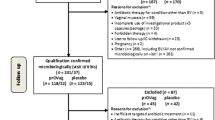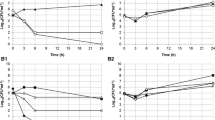Abstract
Bacterial vaginosis (BV) is the most prevalent vaginal infection worldwide and is characterized by reduction of native lactobacilli. Antimicrobial therapy used to cure the disease is often found to be ineffective. We postulate that Bacillus coagulans Unique IS-2 (Unique Biotech Limited, India) might provide an appendage to antimicrobial treatment and improve curing rate. In the present study 40 Indian women diagnosed with BV by the presence of symptoms including white discharge, pH greater than 4.7, burning micturation, itching, soreness and redness at vulva. The subjects were divided in 2 groups probiotic (n = 20) and control (n = 20) based on age (control group, 33 ± 3 years and probiotic group, 32.5 ± 3 years), history of previous vaginosis (control group, 75% or 15/20 and probiotic group, 75% or 15/20) and severity of current vaginosis infection (burning micturation and itching, 35% in each group). Probiotic group subjects were assigned to receive a dose of antibiotic therapy [Ofloxacin–Ornidazole with strength of 200–500 mg per capsule/day for 5 days along with vaginal peccaries (co-kimaxazol) for 3 days] simultaneously with two probiotic capsules (109 CFUs of Bacillus coagulans Unique IS-2 per capsule). The control group received only antibiotic therapy. At the end of the treatment the 80% of probiotic group subjects showed significant positive response as revealed by reduction of vaginosis symptoms compared to the control group which exhibited reduction in 45% subjects only. Thus, the results of present study indicate that strain Bacillus coagulans Unique IS-2 can provide benefits to women being treated with antibiotics to cure an infectious condition.

Similar content being viewed by others
References
Hillier SL (2005) The complexity of microbial diversity in bacterial vaginosis. New Eng J Med 353:1886–1887
Fredricks DN, Fiedler TL, Marrazzo JM (2005) Molecular identification of bacteria associated with bacterial vaginosis. New Eng J Med 353:899–1911
French JI, McGregor JA, Parker R (2006) Readily treatable reproductive tract infections and preterm birth among black women. Am J Obstet Gynecol 194(6):1717–1726
Donder GG, Vereecken A, Bosmans E, Dekeersmaecker A, Salembier G, Spitz B (2002) Definition of a type of abnormal vaginal flora that is distinct from bacterial vaginosis: aerobic vaginitis. Int J Obstet Gynaecol 109:34–43
Cauci S, Guaschino S, Driussi S, De Santo D, Lanzafame P, Quadrifoglio F (2002) Correlation of local interleukin-8 with immunoglobulin A against Gardnerella vaginalis hemolysin and with prolidase and sialidase levels in women with bacterial vaginosis. J Infect Dis 185:1614–1620
Hapsari ED, Hayashi M, Matsuo H (2006) Clinical characteristics of vaginal discharge in bacterial vaginosis diagnosed by Nugent’s criteria. Clin Exp Obstet Gynecol 33:5–9
Anukam KC, Osazuwa E, Osemene GI, Ehigiagbe F, Bruce AW, Reid G (2006) Clinical study comparing probiotic lactobacillus GR-1 and RC-14 with metronidazole vaginal gel to treat symptomatic bacterial vaginosis. Microbes Infect 8:2772–2776
Ness RB, Kip KE, Soper DE, Stamm CA, Rice P, Richter HE (2006) Variability of bacterial vaginosis over 6- to 12-month intervals. Sex Trans Dis 33(6):381–385
Bradshaw CS, Morton AN, Hocking J, Garland SM, Morris MB, Moss LM, Horvath LB, Kuzevska I, Fairley CK (2006) High recurrence rates of bacterial vaginosis over the course of 12 months after oral metronidazole therapy and factors associated with recurrence. J Infect Dis 193:1478–1486
Myer L, Denny L, Telerant R, Souza M, Wright TC, Kuhn L (2005) Bacterial vaginosis and susceptibility to HIV infection in South African women: a nested case-control study. J Infect Dis 192:372–1380
Ya W, Reifer C, Miller LE (2010) Efficacy of vaginal probiotic capsules for recurrent bacterial vaginosis: a double-blind, randomized, placebo controlled study. Am J Obstet Gynecol 203:120.1–120.6
Roger L, Cook, Redondo-lopez V, Schmitt C, Meriwether C, Sobel JD (1992) Clinical, microbiological, and biochemical factors in recurrent bacterial vaginosis. J Clin Microbiol 30(4):870–877
Sudha R, Chauhan P, Dixit K, Babu SM, Jamil K (2010) Molecular typing and probiotic attributes of a new strain of Bacillus coagulans–Unique IS-2: a potential biotherapeutic agent. Genetic Eng Biotechnol J 7:1–20
Reid G, Charbonneau D, Erb J, Kochanowski B, Beuerman D, Poehner R, Bruce AW (2003) Oral use of Lactobacillus rhamnosus GR-1 and L. fermentum RC-14 significantly alters vaginal flora: randomized, placebo-controlled trial in 64 healthy women. FEMS Immunol Med Microbiol 35(2):131–134
Shirodkar NV, Sankholkar PC, Ghosh S, Nulkar SM (1980) Multi-centre clinical assessment of myconip vaginal tablets in non-specific vaginitis. Indian Pract 33:207–210
Author information
Authors and Affiliations
Corresponding author
Rights and permissions
About this article
Cite this article
Ratna Sudha, M., Yelikar, K.A. & Deshpande, S. Clinical Study of Bacillus coagulans Unique IS-2 (ATCC PTA-11748) in the Treatment of Patients with Bacterial Vaginosis. Indian J Microbiol 52, 396–399 (2012). https://doi.org/10.1007/s12088-011-0233-z
Received:
Accepted:
Published:
Issue Date:
DOI: https://doi.org/10.1007/s12088-011-0233-z




